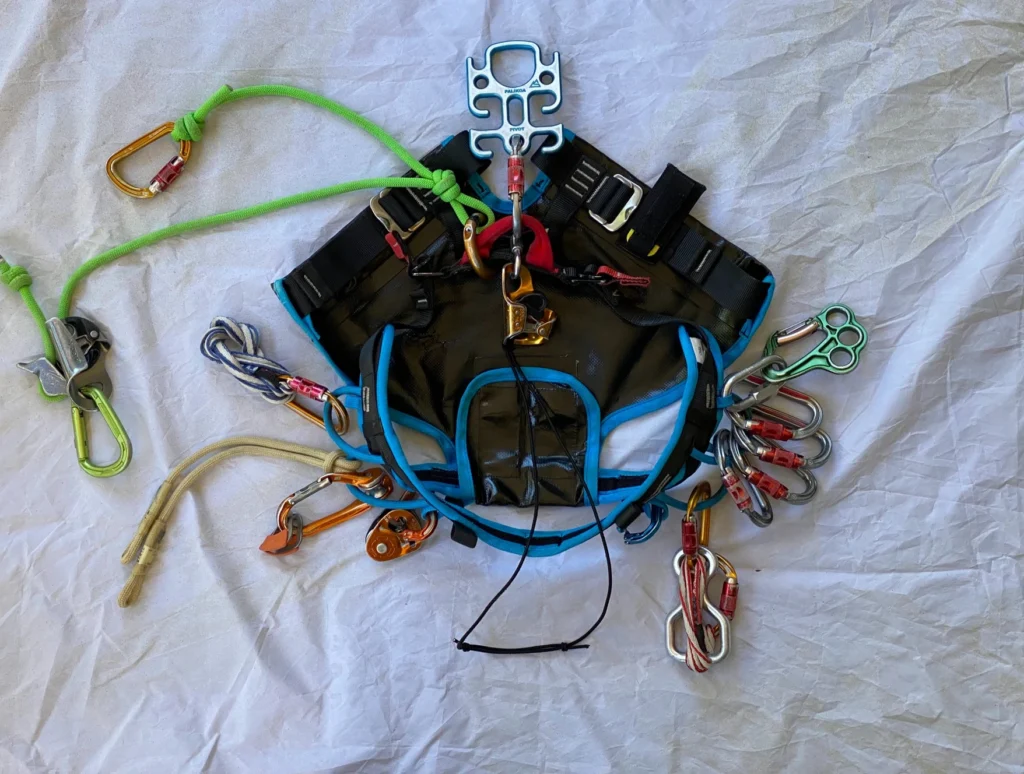Smooth Operator: How to Minimize Snags While Swiftwater Canyoning
When you watch an efficient canyoner move through a complex section of canyon there is a certain smoothness to their movement, an efficiency that seems effortless. Part of that expertise comes from experience, but a significant part comes from something much more simple and deliberate: a clean profile.
In swiftwater, a “clean profile” means having nothing on your harness or pack that can snag, drag, or catch on rock, vegetation, or your own rope. It’s a foundational safety principle that reduces risk, conserves energy, and lets you focus on the adventure.
At Wild Sky Guides, we believe a streamlined setup is a critical component of risk management, and it’s a skill we emphasize from our introductory courses to our advanced training. This post will explore how you can rig your gear to move through the canyon like a pro.
The Safety of a Clean Profile
Getting snagged in a canyon can range from a minor annoyance to a serious emergency. An errant strap caught on a rock during a rappel can leave you stuck. A piece of gear snagging in a tight slot can cause you to lose balance. In swiftwater, a snag can be catastrophic. By taking a few minutes to streamline your setup before you even step in the canyon, you:
Reduce Risk: You dramatically lower the chances of entrapment, especially in flowing water or on rappel.
Conserve Energy: Every time you have to stop to unhook a strap or free a piece of gear, you’re expending physical and mental energy that is better saved for the challenges ahead.
Increase Efficiency: A clean profile allows for smoother, faster, and more confident movement through the canyon environment.
Tame Your Harness
Your harness is your connection to the rope system, but it can also be a major source of snags if not managed properly. Here’s how to clean it up:
- Stow away your slings: Poorly stored slings are primary snag hazards. To minimize snags you should minimize the number of slings you carry on your harness, twist them to fit neatly on your harness. Slings that don’t serve an emergency function should be stored in your backpack.
- Pay Attention To Your Lanyards: Are your lanyards the correct length? Lanyards that are too long can easily get caught on features or tangled in the rope system. If you have adjustable length lanyards size them so that they don’t create a tripping hazard around your knees, but not so short that the extra tail flops around and chocks in surrounding stone.
- Minimize Loops: Excessive loops on your harness are a snag hazard that can entrap you in flow. Common dangerous loops are lanyards with prusiks on them, poorly stowed slings, and rope bag opening closure strings.
- Store Your Descender: Many variable friction descenders work by wrapping the rope around hooks. Those hooks are a primary snag or chocking hazard. You should clip your descender to the side or store it on your gear loop while not in use. Take care when rappelling over edges.
- Rack Your Gear Intelligently: Place your carabiners, descender, and other hardware on your gear loops in an organized way. You can read more about our recommended harness setup HERE.
Streamlining Your Pack
Your backpack protects your gear, but it can also be a bulky liability. The goal is to make its exterior as smooth as possible.
- Everything Inside: The number one rule is to put everything inside the pack. Avoid clipping water bottles, shoes, or other items to the outside. These are practically begging to be snagged and potentially lost.
- Choose a SWIFTWATER CANYONING Specific Pack: Desert canyoneering bags lack essential drainage, have material deficiencies, and are unwieldy in swiftwater canyons.
- Minimize Straps: Canyon packs have a lot of straps: shoulder, sternum, waist, and compression straps. Consider cutting off any straps that are non-essential. The bag closure loop on most canyoning bags is a primary snag hazard. It’s also annoying. Consider removing the cord.
- Wrap the bag waist belt around your bag: While not essential in low flow this technique can be lifesaving in high flow canyons.
The Safety of a Clean Profile
Adopting a clean-profile mindset is a simple way to improve safety, efficiency, and fun while canyoning. Before your next canyon, take a critical look at your harness and pack. Every strap you tuck away and every piece of gear you secure is another step toward becoming a smoother, safer, and more confident canyoneer.
Are You Part of Washington's SAR Community?
Search and Rescue team leaders or members in Western Washington interested in developing potentially State-supported SAR canyoning training opportunities with Wild Sky Adventure Guides are encouraged to make contact. Wild Sky Guides is planning for 2026 and beyond and is open to discussions on how to build a more skilled and prepared rescue community.

